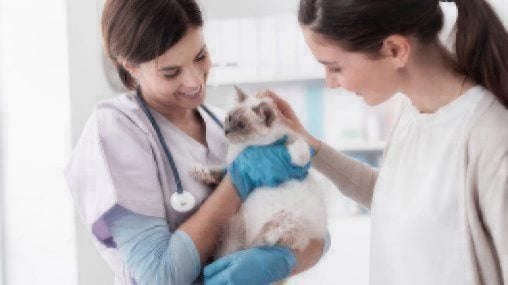Table of Contents

Hookworms are thread-like worms about a half-inch long that live in the digestive system of cats (and dogs). Hookworms attach to the lining of the intestinal wall and feed on the cat’s blood. Because they are so small, they are not visible in feces, and they are long-lived – they can actually live as long as the cat.
Your cat can be infected when hookworm larvae penetrate the skin (usually through the paws), or if she ingests the larvae when she cleans herself. Depending on contraction, the worms can then migrate to the lungs, or they go directly to the intestines where they mature into adult worms.
Hookworms can cause bleeding into the intestinal tract and blood transfusions may be needed to keep young kittens alive long enough for medications to take effect.
Symptoms
- Lesions between the toes
- Coughing
- Constipation
- Diarrhea
- Dark and tarry stool
- Loss of appetite
- Pale mucous membranes
- Unhealthy appearance
Diagnosis of a hookworm infection is made via a microscopic exam of your cat’s stool. The presence of eggs will confirm the diagnosis.
Treatment
Deworming medications are simple, safe and relatively inexpensive. Since these medications don’t treat larvae, you will need to treat your cat two or three times, typically at two or three-week intervals.
The Companion Animal Parasite Council (CAPC) says infections in kittens are common, so they advise a frequent treatment schedule. Between 3 and 9 weeks of age, kittens should be treated every two weeks and after that a monthly treatment is advised. During the first year, fecal examinations should be done 2 to 4 times and for adults, once or twice a year is advised.
Preventative Measures
You can prevent hookworm infestation with the following tools:
- Pet parents should practice year-round prevention by using oral medication or topical preventives such as Revolution (Revolution provides protection from hookworms as well as roundworms, ear mites, fleas and heartworm disease). This routine care will also reduce environmental contamination.
- You can minimize the likelihood of your cat being infected with hookworms by keeping her indoors, away from a contaminated environment.
- Proper sanitation is also important as the hookworm is shed through feces. Feces should be promptly removed from litter boxes. Clean the litter box with a solution of one cup chlorine bleach in one gallon of water. Be sure to rinse the box thoroughly as bleach is toxic to cats. Wear gloves when you clean the litter box and wash your hands thoroughly afterward.
Can I Get Hookworms from My Cat?
You can’t contract hookworms from your cat, but you can become infected while walking barefoot or if exposed skin comes in contact with contaminated soil or sand. The hookworm larvae migrate under the skin and cause itchy red, raised lesions on the feet or lower parts of the leg. In most people, this resolves without medical treatment, but treatment may help control symptoms and help prevent secondary bacterial infections. If you become infected you may be prescribed antiparasitic medication.
Wearing shoes to avoid skin contact with contaminated sand or soil will prevent hookworm infection. In addition, practicing good hygiene – including washing hands before eating, cleaning soil from vegetables, and reducing exposure to cat feces – can prevent hookworm infection.
By enrolling your cat early, conditions and illnesses like parasite infection treatments will be covered up to 90% by your Healthy Paws pet insurance. Find out more by getting a free quote.
The content is not intended to be a substitute for professional veterinarian advice, diagnosis, or treatment. Always seek the advice of your veterinarian or other qualified health provider with any questions you may have regarding a medical diagnosis, condition, or treatment options.






